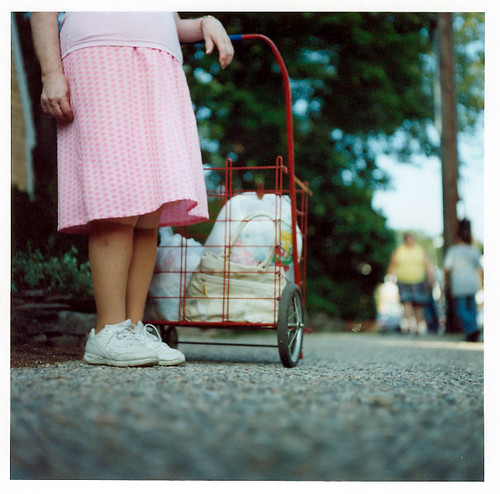Every Saturday, we post a piece from the CHG archives, which are kept on microfiche in the New York City Public Library's main branch, right next to a copy of the U.S. Constitution. This one's from December 2007.
 (I want to apologize up front for the New York-centrism of this post. I do hope it helps others in metro areas, though, and I would love, Love, LOVE to get comments, feedback and suggestions.)
(I want to apologize up front for the New York-centrism of this post. I do hope it helps others in metro areas, though, and I would love, Love, LOVE to get comments, feedback and suggestions.)Since 2000, I’ve lived in seven apartments in three different boroughs of New York City. The rentals have ranged from a spacious three-bedroom in a riverside high-rise to a microscopic box adjacent to a dive bar. While I’ve truly liked almost every place, each has presented some interesting obstacles for grocery shopping. Since a lot of big city apartment-dwellers have probably met with the same hurdles, I figure I’d address a few and provide alternatives.
See, we urbanites face a unique set of issues when we buy food. Space is our main problem, meaning bulk buying, gardening, and canning can be very difficult, if not impossible. Transportation is another biggie. Lots of metro citizens don’t have access to cars. Public buses and subways are wonderful, but make it difficult to carry much of anything. Lack of access to fresh food is also a concern, since the nearest farm or farmers market can be miles away. Finally, there’s good ol’ price. Depending on the city or neighborhood in which one lives, a box of cereal can be twice the cost of one two miles away. Economics are tricky like that.
Fret not, though. All isn’t lost, as city-zens have two assets that suburban peeps and rural folk generally don’t: proximity and ethnic diversity. I live within a ten-minute walk of at least three major grocery stores, so circular sales can save me a lot of dough. What’s more, dozens of bodegas, Korean groceries, and polish delis line the streets of my borough, so I’m never at a loss for variety.
With those six areas (Space, Transportation, Lack of Access to Fresh Food, Price, Proximity, Ethnic Diversity) in mind, here are a few tips to making the most of grocery shopping and storage in Gotham. (Or Seattle.) (Or San Francisco.) (Or Chicago.) (“Or Boston,” The Boyfriend says.) (“And don’t forget Philly. It’s nice there. There’s a bell.”)
SPACE

Be creative with storage. Install high shelving. Snag a kitchen cart or pot rack off Craigslist. Pack food in places it wouldn’t normally go (under the bed, in the closet, etc). Draw up a floor plan of your flat and see where storage furniture can fit best. Any out-of-the-box thinking can help you stock and keep goods at home. Apartment Therapy: The Kitchen (now just TheKitchn) has some great ideas.
Make a deal with neighbors or roommates. I confess I’ve never done this myself. (New York is kind of isolationist that way.) Yet, if you have neighbors or pals you trust, you might be able to rent or barter for a shelf or two.
Try single pot, balcony, or window gardening. Impossible, you say? Look at this lady! And this one! And this … uh, this one doesn’t mention their gender, but look at ‘em anyway! You may never have that pumpkin patch you’ve dreamed of, but a batch of fresh basil is in reach. Rachel, the Cheap Healthy Gourmet, succeeded in growing said basil, as well as dill, and mint (mint, and more mint) in her place. Another roommate coaxed 48,000 Italian peppers out of our harsh Brooklyn soil. Even if you have the blackest of thumbs, it’s worth a shot.
Sign up for a bulk warehouse, but buy only what you can carry. Certain BJ’s and CostCo deals are unbeatable, but cramming a 128-oz. jar of mustard into an already-crowded cabinet is not gonna happen in most apartments. Instead of whole-hog bulk shopping, go every month or two and bring home only what you can lift. You’ll still score the deals, you can still use public transportation, and occupied square footage will be kept to a minimum.
TRANSPORTATION
Rent a car and split the cost between friends. A three-hour rental in the middle of the day can be relatively inexpensive and very helpful to a group that’s dividing the fee. If Enterprise or Avis aren’t feasible, lots of cities have services like Zipcar nowadays. For $8.50/hr, you can have a vehicle for as long as you like.
 Snag an Old Lady Cart off of Craigslist, eBay, or the local Dollar Store shelf. You may ask yourself,
Snag an Old Lady Cart off of Craigslist, eBay, or the local Dollar Store shelf. You may ask yourself, Bike it. If you have a cycle, go to town. Or rather, go to a place where there are cheap groceries. You’ll get a good workout, and it’s blessedly free.
LACK OF ACCESS TO FRESH FOOD
Visit available farmers’ markets. The USDA and Local Harvest have lovely sites on which you can pinpoint the farmers’ markets closest to you. Scout a few, figure out if the expenditure’s worth it, and proceed accordingly. In the city, it’s the closest you might come to a freshly-picked ear of corn.
Make friends with a butcher, fishmonger, or produce … uh, guy. Generations of New Yorkers have scored prime cuts of meat because they have friendly relationships with Buddy the Butcher down the block. Nobody knows food like the people who catch and cut it up for you. So, make a friend! Ask him (or her) what to buy! If you find his suggestions tasty and reasonably-priced, stick with him for life. Or at least ‘til you have to move again.
Ask a waitress, maitre’d or chef. Restaurant workers know where to buy the freshest, least expensive produce, meat, fish, and extras out there. If they’re any good, they have to. Speaking up, rattling off questions, and taking notes can point you in the direction of infinite and wonderful culinary discoveries.
Check out the Food Trust’s Supermarket Campaign. The New York Times recently reported that the rumors are true – calorie for calorie, junk food costs less than healthy food. It hurts low income earners the most. Based in Pennsylvania, the Food Trust is looking to combat the issue by making fresh vegetables and fruit available to people in the inner city. If you’re in the area and need the assistance, this could be a great boon to your savings.
PRICE
Use specialty and high-end markets sparingly. In Manhattan at least, Whole Foods seems to be competing with Starbucks for the 2007 Overpriced and Omnipresent Awards. If you’re in search of a pre-marinated rack of lamb to serve your boss and his grandmother, go nuts. But if you’re shopping for a can of beans and a 30-lb bag of rice, avoid fancy grocers at all costs.
Beware faux-organic stores. The booming gentrification of Brooklyn has given birth to a new breed of market. It’s the overpriced, quasi-gourment “organic” store, where there are few vegetables and a box of butternut squash soup will run $4. Try to avoid these places if possible. They might look nice, but it’ll cost a bundle each and every time. (A single cookie for $2.50? You gotta be kidding.)
Look for drugstore deals. Though they’re not cornucopias of fresh food, CVS, Walgreens, Rite Aid and other chains are staple extravaganzas. What’s more, they have sales and offers that few people know about. Crystal at Money Saving Mom and Kacie at Sense to Save have written extensively about these bargains, so start reading.
Shop at Target or Trader Joe’s. I’ve found that both these bigger box stores often have better values than local supermarkets. Knowing what to look for is key, though. If you can (and if they’re available) spend a few minutes taking mental notes of prices and foods you like. From cereal to wine to a dozen eggs, odds are you’ll find a good deal somewhere in there.
Follow all the rules that suburban and rural people do. Start a price book. Plan your menus ahead. Make lists. Shop for loss-leaders. Don’t buy groceries when you’re hungry. Avoid impulse buys. What works for the homeschooling mom of 37 will work for the single urbanite just out of college. (Except for the breastmilk stuff. Never mind about that.)
PROXIMITY
Scope your ‘hood. Every area I’ve ever lived in has held some pleasant culinary surprises. Smaller stores may not have a website or be listed in a city guide, but a stroll around the block can reveal that spice market you’ve been secretly hoping for.
Check circulars online and compare surrounding stores. Oh, sweet Google Maps. You used to just tell me my zip code when I forgot it after the 6th move. Now you can list every supermarket (with address and phone number) within a five block radius of my humble abode. You also connect to websites, which have circulars, sales, and special discounts. Google maps, will you marry me? The Boyfriend won’t mind. He likes your layout.
Hit up a variety of vendors for sales. Inside an hour or two, I can hit up three different markets, buying loss-leader weekly groceries at each. (BAM!) I know a lot of cities aren’t as tightly-packed as New York (where I live within ten feet of 47 families of eight), but urban layouts can mean lots of choices, which in turn mean big savings. Try the just-mentioned Google Maps to plot your plan of attack or space your shopping trips out over the course of a week.
ETHNIC DIVERSITY
Go ethnic. I’ve written pretty extensively on the wonders of ethnic markets, but their prices and selection are often unbeatable.
Visit stores out of your comfort zone. Are you a tiny Ohio woman who doesn’t speak a lick of Korean? Are you a born-and-bred Detroit native who wouldn’t know Arabic if it jumped up and gave you a wedgie? Different cultures may be, uh, foreign to us, but taking a walk in a different neighborhood can familiarize you with a unique cuisine and a whole new set of people.
Take a cooking class focusing on dishes from another culture. While they might cost a bit up front, cooking classes can pay off huge in the long run. Learning to prepare foreign dishes will open up your palate, provide more shopping (and saving) opportunities, and make friends and influence people.
That’s it. Again, I’d love to hear comments and suggestions. Thanks for reading!
(Photos courtesy of Flickr.)

